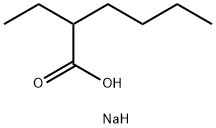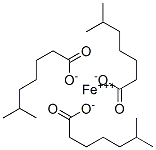Lead bis(2-ethylhexanoate)
- CAS NO.:301-08-6
- Empirical Formula: C16H30O4Pb
- Molecular Weight: 493.61
- MDL number: MFCD00014003
- EINECS: 206-107-0
- SAFETY DATA SHEET (SDS)
- Update Date: 2025-04-14 20:14:38

What is Lead bis(2-ethylhexanoate)?
Chemical properties
visc liquid [CRC10]
The Uses of Lead bis(2-ethylhexanoate)
Films of lead (II) 2-ethylhexanote can be cast on silicon solutions by spin coating. Lead (II) 2-ethylhexanote is a common solvent in metal-organic deposition (MOD) process. Intermetallic PtPb nanoparticles have been synthesized by the chemical reduction of dimethyl(1,5-cyclooctadiene)platinum and lead(II)2-ethylhexanoate by sodium naphthalide in THF or diglyme. The precursors used for the photochemical production of PZT or PLZT films were lead(II) 2-ethylhexanoate, lanthanum(III) 2-ethylhexanoate, zirconyl(IV) 2-ethylhexa- noate, and titanium(IV) isopropoxide.
Properties of Lead bis(2-ethylhexanoate)
| Density | 1,56 g/cm3 |
| Flash point: | 162°C |
| form | liquid |
| Specific Gravity | 1.56 |
| color | viscous |
| Water Solubility | Insoluble in water. |
| Hydrolytic Sensitivity | 4: no reaction with water under neutral conditions |
| Exposure limits | NIOSH: IDLH 100 mg/m3; TWA 0.050 mg/m3 |
| CAS DataBase Reference | 301-08-6(CAS DataBase Reference) |
| EPA Substance Registry System | Lead(II) 2-ethylhexanoate (301-08-6) |
Safety information for Lead bis(2-ethylhexanoate)
| Pictogram(s) |
 Exclamation Mark Irritant GHS07  Health Hazard GHS08  Environment GHS09 |
| GHS Hazard Statements |
H302:Acute toxicity,oral H332:Acute toxicity,inhalation H360:Reproductive toxicity H373:Specific target organ toxicity, repeated exposure H400:Hazardous to the aquatic environment, acute hazard H410:Hazardous to the aquatic environment, long-term hazard |
| Precautionary Statement Codes |
P201:Obtain special instructions before use. P273:Avoid release to the environment. P308+P313:IF exposed or concerned: Get medical advice/attention. |
Computed Descriptors for Lead bis(2-ethylhexanoate)
New Products
4,4-Difluoropiperidine hydrochloride tert-butyl 9-methoxy-3-azaspiro[5.5]undecane-3-carboxylate Indole Methyl Resin N-Isopropylurea N,N-Dicyclohexylcarbodiimide(DCC) MELDRUMS ACID 5-METHYLISOXAZOLE-4-CARBOXYLIC ACID Magnessium Bis glycinate Zinc ascorbate 1-bromo-2-butyne 2-acetamidophenol 9(10H)-anthracenone Erythrosin B, 4-Piperidinopiperidine 2-((4-morpholinophenylamino) (methylthio) methylene) malononitrile 2,4-dihydroxybenzaldehyde 3-(4-morpholinophenylamino)-5-amino-1H-pyrazole-4-carbonitrile Methyl 2-methylquinoline-6-carboxylate 2,6-dichloro-4-nitropyridine 4-Bromo-2-chlorobenzonitrile 2-(benzylamino)acetic acid hydrochloride 4-(tert-Butoxycarbonylamino)but- 2-ynoic acid 3,4-dihydro-2H-benzo[b][1,4]dioxepine 1-Phenyl-1-cycloprppanecarboxylicacidRelated products of tetrahydrofuran








You may like
-
 Lead(II) 2-ethylhexanoate CAS 301-08-6View Details
Lead(II) 2-ethylhexanoate CAS 301-08-6View Details
301-08-6 -
 Lead(II) 2-ethylhexanoate CAS 301-08-6View Details
Lead(II) 2-ethylhexanoate CAS 301-08-6View Details
301-08-6 -
 3-(4-amino-1-oxoisoindolin-2-yl)-1-methylpiperidine-2,6-dione 98%View Details
3-(4-amino-1-oxoisoindolin-2-yl)-1-methylpiperidine-2,6-dione 98%View Details -
 614-19-7 98%View Details
614-19-7 98%View Details
614-19-7 -
 20677-73-0 (2,2-diethoxyethyl)methylamine 98%View Details
20677-73-0 (2,2-diethoxyethyl)methylamine 98%View Details
20677-73-0 -
 3-(4-(hydroxyamino)-1-oxoisoindolin-2-yl)piperidine-2,6-dione 98%View Details
3-(4-(hydroxyamino)-1-oxoisoindolin-2-yl)piperidine-2,6-dione 98%View Details -
 57381-49-4 2-bromo-4-chlorobenzonitrile 98%View Details
57381-49-4 2-bromo-4-chlorobenzonitrile 98%View Details
57381-49-4 -
 4,6-dichloropyrimidine-5-carbaldehyde 98%View Details
4,6-dichloropyrimidine-5-carbaldehyde 98%View Details
5305-40-8
Statement: All products displayed on this website are only used for non medical purposes such as industrial applications or scientific research, and cannot be used for clinical diagnosis or treatment of humans or animals. They are not medicinal or edible.
